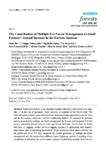Use este identificador para citar ou linkar para este item:
http://www.alice.cnptia.embrapa.br/alice/handle/doc/989173| Título: | The contribution of multiple use forest management to small farmers' Annual Incomes in the Eastern Amazon. |
| Autoria: | SIST, P.  SABLAYROLLES, P.   BARTHELON, S.   SOUSA-OTA, L.   KIBLER, J.-F.   RUSCHEL, A.   SANTOS-MELO, M.   EZZINE-DE-BLAS, D.   |
| Afiliação: | Plinio Sist, CIRAD; Philippe Sablayrolles, Gret (Groupe de recherche et d'échanges technologiques); Sophie Barthelon, Gret (Groupe de recherche et d'échanges technologiques); Liz Sousa-Ota, UNESP; Jean-François Kibler, Gret (Groupe de recherche et d'échanges technologiques); ADEMIR ROBERTO RUSCHEL, CPATU; Marcelo Santos-Melo, Serviço Florestal Brasileiro MMA/SFB; Driss Ezzine-de-Blas, CIRAD. |
| Ano de publicação: | 2014 |
| Referência: | Forests, v. 5, n. 7, p. 1508-1531, 2014. |
| Conteúdo: | Small-scale farmers in the Brazilian Amazon collectively hold tenure over more than 12 million ha of permanent forest reserves, as required by the Forest Code. The trade-off between forest conservation and other land uses entails opportunity costs for them and for the country, which have not been sufficiently studied. We assessed the potential income generated by multiple use forest management for farmers and compared it to the income potentially derived from six other agricultural land uses. Income from the forest was from (i) logging, carried out by a logging company in partnership with farmers? associations; and (ii) harvesting the seeds of Carapa guianensis (local name andiroba) for the production of oil. We then compared the income generated by multiple-use forest management with the income from different types of agrarian systems. According to our calculations in this study, the mean annual economic benefits from multiple forest use are the same as the least productive agrarian system, but only 25% of the annual income generated by the most productive system. Although the income generated by logging may be considered low when calculated on an annual basis and compared to incomes generated by agriculture, the one-time payment after logging is significant (US$5,800 to US$33,508) and could be used to implement more intensive and productive cropping systems such as planting black pepper. The income from forest management could also be used to establish permanent fields in deforested areas for highly productive annual crops using conservation agriculture techniques. These techniques are alternatives to the traditional land use based on periodic clearing of the forest. Nevertheless, the shift in current practices towards adoption of more sustainable conservation agriculture techniques will also require the technical and legal support of the State to help small farmers apply these alternatives, which aim to integrate forest management in sustainable agricultural production systems. |
| Thesagro: | Agricultura Familiar |
| NAL Thesaurus: | Amazonia community forestry |
| Palavras-chave: | Manejo florestal Uso múltiplo Manejo florestal comunitário Produto florestal não-madeireiro Multiple-use forest management Non-timber forest products Small farming |
| Digital Object Identifier: | http://dx.doi.org/10.3390/f5071508 |
| Tipo do material: | Artigo de periódico |
| Acesso: | openAccess |
| Aparece nas coleções: | Artigo em periódico indexado (CPATU)  |
Arquivos associados a este item:
| Arquivo | Descrição | Tamanho | Formato | |
|---|---|---|---|---|
| forests0501508v2.pdf | 587,33 kB | Adobe PDF |  Visualizar/Abrir |









